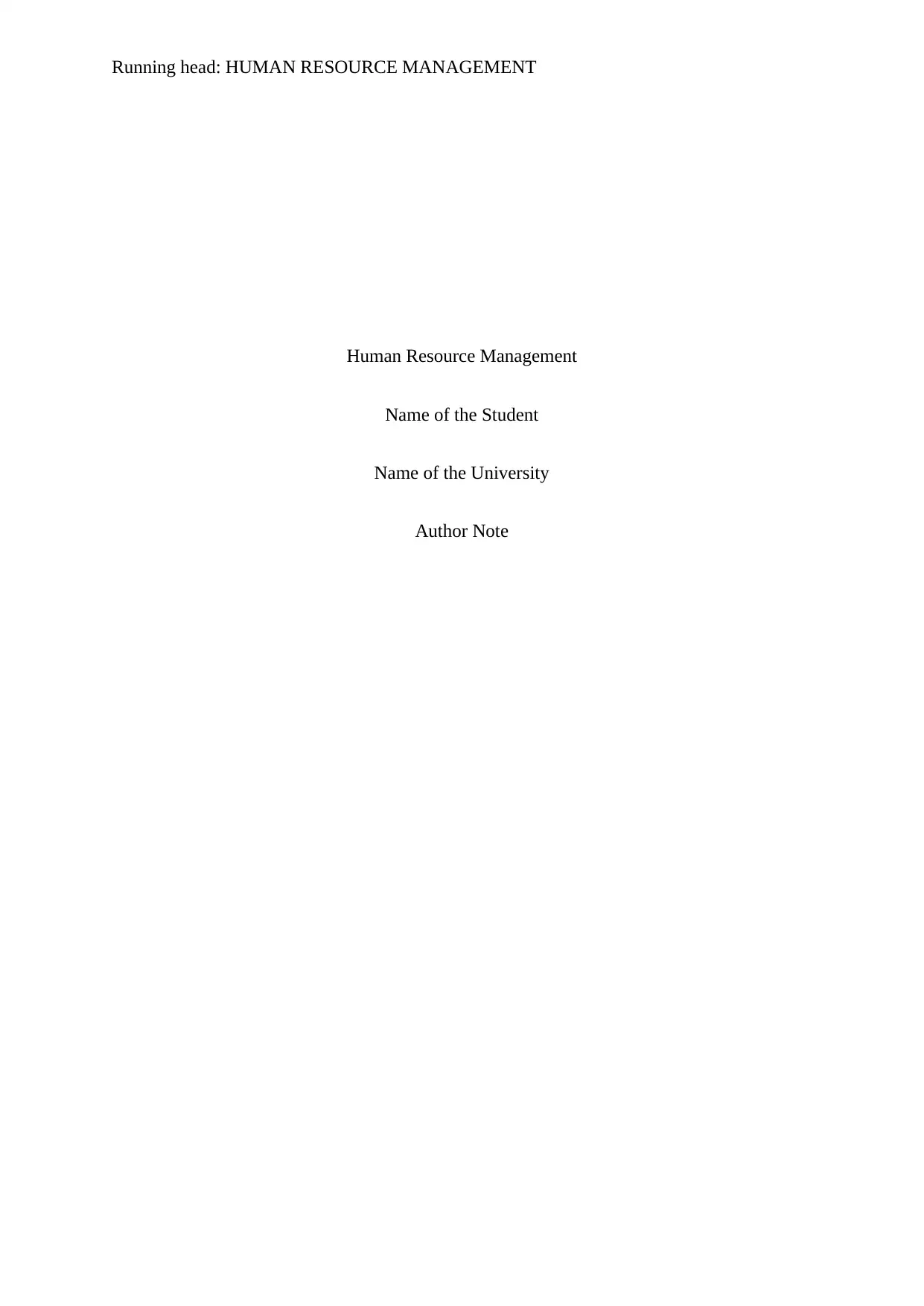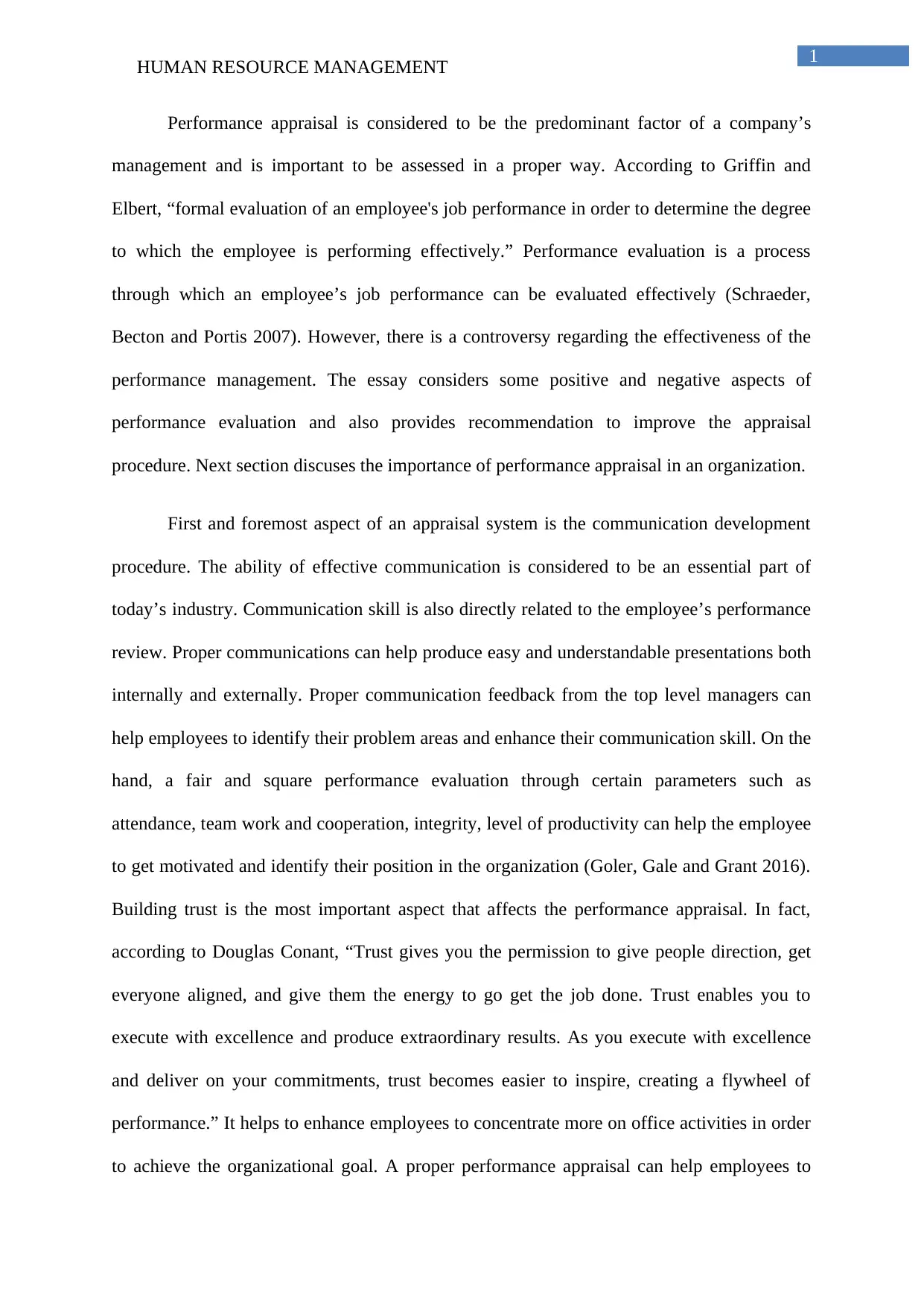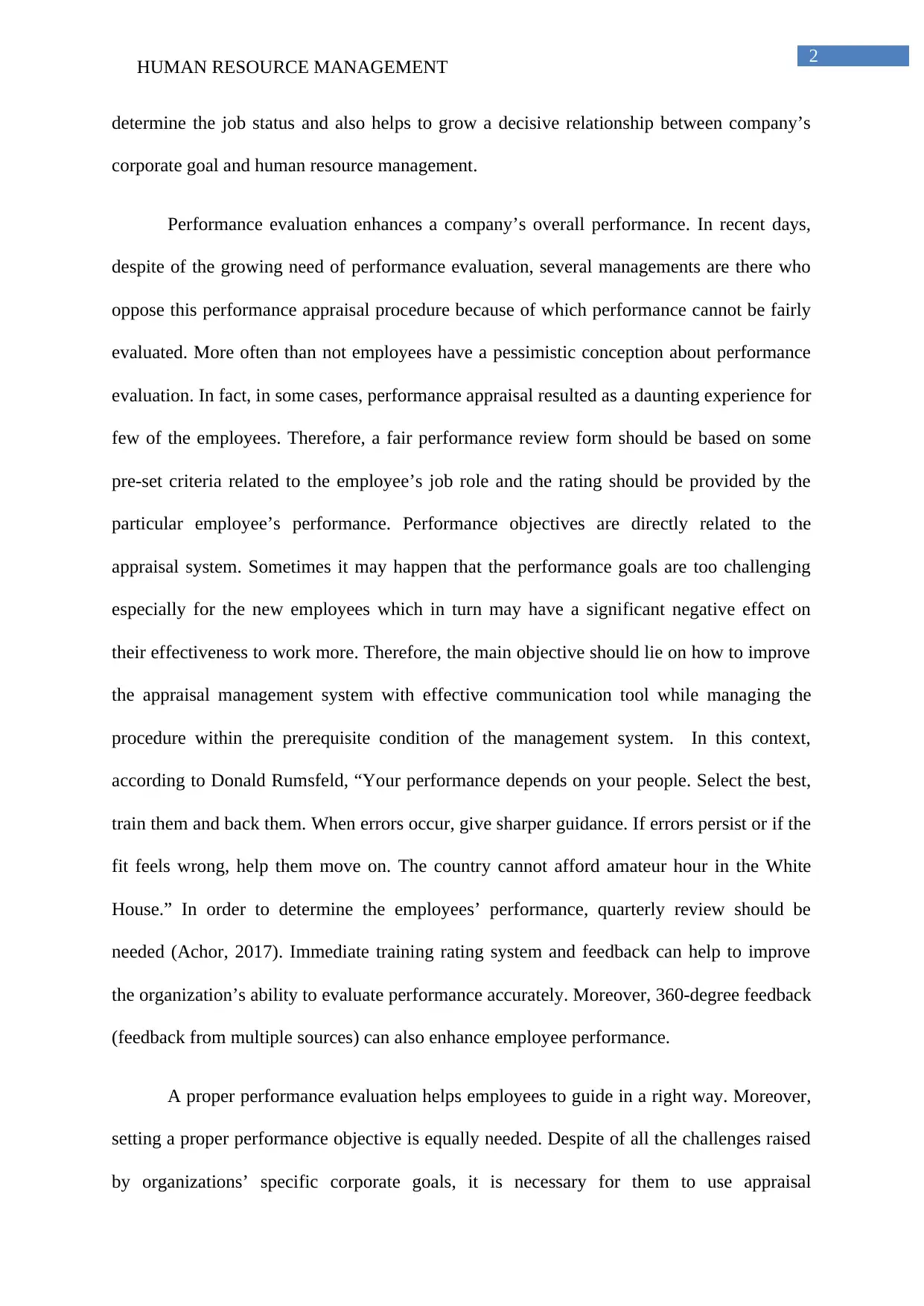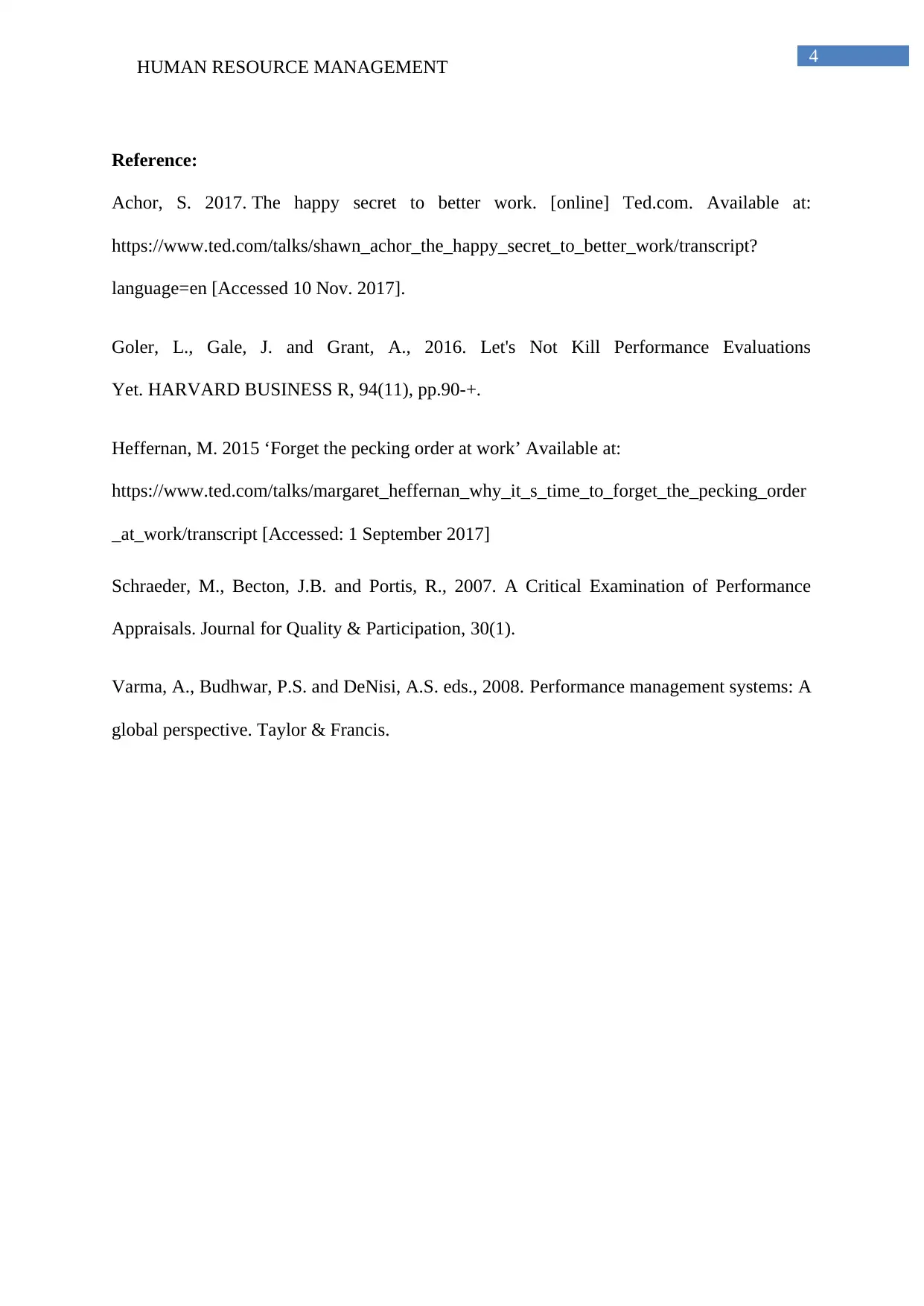Human Resource Management: A Detailed Look at Performance Appraisal
VerifiedAdded on 2020/04/21
|5
|947
|135
Essay
AI Summary
This essay delves into the critical role of performance appraisal within Human Resource Management (HRM). It begins by defining performance appraisal and highlighting its significance in evaluating employee job performance, referencing key academic sources. The essay explores both the positive and negative aspects of performance evaluation, emphasizing the importance of communication development, trust-building, and employee motivation. It examines how effective communication and feedback can improve employee performance and how a fair appraisal system, based on pre-set criteria, can enhance employee morale and organizational performance. The essay also addresses the challenges associated with performance objectives and offers recommendations for improving the appraisal process, including the use of 360-degree feedback and immediate training. Overall, the essay underscores the need for organizations to effectively utilize appraisal management tools to achieve their corporate goals.

Running head: HUMAN RESOURCE MANAGEMENT
Human Resource Management
Name of the Student
Name of the University
Author Note
Human Resource Management
Name of the Student
Name of the University
Author Note
Paraphrase This Document
Need a fresh take? Get an instant paraphrase of this document with our AI Paraphraser

1
HUMAN RESOURCE MANAGEMENT
Performance appraisal is considered to be the predominant factor of a company’s
management and is important to be assessed in a proper way. According to Griffin and
Elbert, “formal evaluation of an employee's job performance in order to determine the degree
to which the employee is performing effectively.” Performance evaluation is a process
through which an employee’s job performance can be evaluated effectively (Schraeder,
Becton and Portis 2007). However, there is a controversy regarding the effectiveness of the
performance management. The essay considers some positive and negative aspects of
performance evaluation and also provides recommendation to improve the appraisal
procedure. Next section discuses the importance of performance appraisal in an organization.
First and foremost aspect of an appraisal system is the communication development
procedure. The ability of effective communication is considered to be an essential part of
today’s industry. Communication skill is also directly related to the employee’s performance
review. Proper communications can help produce easy and understandable presentations both
internally and externally. Proper communication feedback from the top level managers can
help employees to identify their problem areas and enhance their communication skill. On the
hand, a fair and square performance evaluation through certain parameters such as
attendance, team work and cooperation, integrity, level of productivity can help the employee
to get motivated and identify their position in the organization (Goler, Gale and Grant 2016).
Building trust is the most important aspect that affects the performance appraisal. In fact,
according to Douglas Conant, “Trust gives you the permission to give people direction, get
everyone aligned, and give them the energy to go get the job done. Trust enables you to
execute with excellence and produce extraordinary results. As you execute with excellence
and deliver on your commitments, trust becomes easier to inspire, creating a flywheel of
performance.” It helps to enhance employees to concentrate more on office activities in order
to achieve the organizational goal. A proper performance appraisal can help employees to
HUMAN RESOURCE MANAGEMENT
Performance appraisal is considered to be the predominant factor of a company’s
management and is important to be assessed in a proper way. According to Griffin and
Elbert, “formal evaluation of an employee's job performance in order to determine the degree
to which the employee is performing effectively.” Performance evaluation is a process
through which an employee’s job performance can be evaluated effectively (Schraeder,
Becton and Portis 2007). However, there is a controversy regarding the effectiveness of the
performance management. The essay considers some positive and negative aspects of
performance evaluation and also provides recommendation to improve the appraisal
procedure. Next section discuses the importance of performance appraisal in an organization.
First and foremost aspect of an appraisal system is the communication development
procedure. The ability of effective communication is considered to be an essential part of
today’s industry. Communication skill is also directly related to the employee’s performance
review. Proper communications can help produce easy and understandable presentations both
internally and externally. Proper communication feedback from the top level managers can
help employees to identify their problem areas and enhance their communication skill. On the
hand, a fair and square performance evaluation through certain parameters such as
attendance, team work and cooperation, integrity, level of productivity can help the employee
to get motivated and identify their position in the organization (Goler, Gale and Grant 2016).
Building trust is the most important aspect that affects the performance appraisal. In fact,
according to Douglas Conant, “Trust gives you the permission to give people direction, get
everyone aligned, and give them the energy to go get the job done. Trust enables you to
execute with excellence and produce extraordinary results. As you execute with excellence
and deliver on your commitments, trust becomes easier to inspire, creating a flywheel of
performance.” It helps to enhance employees to concentrate more on office activities in order
to achieve the organizational goal. A proper performance appraisal can help employees to

2
HUMAN RESOURCE MANAGEMENT
determine the job status and also helps to grow a decisive relationship between company’s
corporate goal and human resource management.
Performance evaluation enhances a company’s overall performance. In recent days,
despite of the growing need of performance evaluation, several managements are there who
oppose this performance appraisal procedure because of which performance cannot be fairly
evaluated. More often than not employees have a pessimistic conception about performance
evaluation. In fact, in some cases, performance appraisal resulted as a daunting experience for
few of the employees. Therefore, a fair performance review form should be based on some
pre-set criteria related to the employee’s job role and the rating should be provided by the
particular employee’s performance. Performance objectives are directly related to the
appraisal system. Sometimes it may happen that the performance goals are too challenging
especially for the new employees which in turn may have a significant negative effect on
their effectiveness to work more. Therefore, the main objective should lie on how to improve
the appraisal management system with effective communication tool while managing the
procedure within the prerequisite condition of the management system. In this context,
according to Donald Rumsfeld, “Your performance depends on your people. Select the best,
train them and back them. When errors occur, give sharper guidance. If errors persist or if the
fit feels wrong, help them move on. The country cannot afford amateur hour in the White
House.” In order to determine the employees’ performance, quarterly review should be
needed (Achor, 2017). Immediate training rating system and feedback can help to improve
the organization’s ability to evaluate performance accurately. Moreover, 360-degree feedback
(feedback from multiple sources) can also enhance employee performance.
A proper performance evaluation helps employees to guide in a right way. Moreover,
setting a proper performance objective is equally needed. Despite of all the challenges raised
by organizations’ specific corporate goals, it is necessary for them to use appraisal
HUMAN RESOURCE MANAGEMENT
determine the job status and also helps to grow a decisive relationship between company’s
corporate goal and human resource management.
Performance evaluation enhances a company’s overall performance. In recent days,
despite of the growing need of performance evaluation, several managements are there who
oppose this performance appraisal procedure because of which performance cannot be fairly
evaluated. More often than not employees have a pessimistic conception about performance
evaluation. In fact, in some cases, performance appraisal resulted as a daunting experience for
few of the employees. Therefore, a fair performance review form should be based on some
pre-set criteria related to the employee’s job role and the rating should be provided by the
particular employee’s performance. Performance objectives are directly related to the
appraisal system. Sometimes it may happen that the performance goals are too challenging
especially for the new employees which in turn may have a significant negative effect on
their effectiveness to work more. Therefore, the main objective should lie on how to improve
the appraisal management system with effective communication tool while managing the
procedure within the prerequisite condition of the management system. In this context,
according to Donald Rumsfeld, “Your performance depends on your people. Select the best,
train them and back them. When errors occur, give sharper guidance. If errors persist or if the
fit feels wrong, help them move on. The country cannot afford amateur hour in the White
House.” In order to determine the employees’ performance, quarterly review should be
needed (Achor, 2017). Immediate training rating system and feedback can help to improve
the organization’s ability to evaluate performance accurately. Moreover, 360-degree feedback
(feedback from multiple sources) can also enhance employee performance.
A proper performance evaluation helps employees to guide in a right way. Moreover,
setting a proper performance objective is equally needed. Despite of all the challenges raised
by organizations’ specific corporate goals, it is necessary for them to use appraisal
⊘ This is a preview!⊘
Do you want full access?
Subscribe today to unlock all pages.

Trusted by 1+ million students worldwide

3
HUMAN RESOURCE MANAGEMENT
management tool in the near future. According to Jay Samit, “To be successful, innovation is
not just about value creation, but value capture.”
HUMAN RESOURCE MANAGEMENT
management tool in the near future. According to Jay Samit, “To be successful, innovation is
not just about value creation, but value capture.”
Paraphrase This Document
Need a fresh take? Get an instant paraphrase of this document with our AI Paraphraser

4
HUMAN RESOURCE MANAGEMENT
Reference:
Achor, S. 2017. The happy secret to better work. [online] Ted.com. Available at:
https://www.ted.com/talks/shawn_achor_the_happy_secret_to_better_work/transcript?
language=en [Accessed 10 Nov. 2017].
Goler, L., Gale, J. and Grant, A., 2016. Let's Not Kill Performance Evaluations
Yet. HARVARD BUSINESS R, 94(11), pp.90-+.
Heffernan, M. 2015 ‘Forget the pecking order at work’ Available at:
https://www.ted.com/talks/margaret_heffernan_why_it_s_time_to_forget_the_pecking_order
_at_work/transcript [Accessed: 1 September 2017]
Schraeder, M., Becton, J.B. and Portis, R., 2007. A Critical Examination of Performance
Appraisals. Journal for Quality & Participation, 30(1).
Varma, A., Budhwar, P.S. and DeNisi, A.S. eds., 2008. Performance management systems: A
global perspective. Taylor & Francis.
HUMAN RESOURCE MANAGEMENT
Reference:
Achor, S. 2017. The happy secret to better work. [online] Ted.com. Available at:
https://www.ted.com/talks/shawn_achor_the_happy_secret_to_better_work/transcript?
language=en [Accessed 10 Nov. 2017].
Goler, L., Gale, J. and Grant, A., 2016. Let's Not Kill Performance Evaluations
Yet. HARVARD BUSINESS R, 94(11), pp.90-+.
Heffernan, M. 2015 ‘Forget the pecking order at work’ Available at:
https://www.ted.com/talks/margaret_heffernan_why_it_s_time_to_forget_the_pecking_order
_at_work/transcript [Accessed: 1 September 2017]
Schraeder, M., Becton, J.B. and Portis, R., 2007. A Critical Examination of Performance
Appraisals. Journal for Quality & Participation, 30(1).
Varma, A., Budhwar, P.S. and DeNisi, A.S. eds., 2008. Performance management systems: A
global perspective. Taylor & Francis.
1 out of 5
Related Documents
Your All-in-One AI-Powered Toolkit for Academic Success.
+13062052269
info@desklib.com
Available 24*7 on WhatsApp / Email
![[object Object]](/_next/static/media/star-bottom.7253800d.svg)
Unlock your academic potential
Copyright © 2020–2025 A2Z Services. All Rights Reserved. Developed and managed by ZUCOL.




